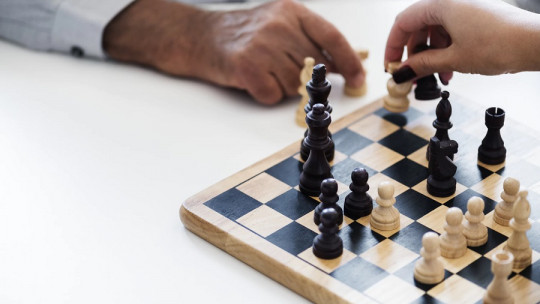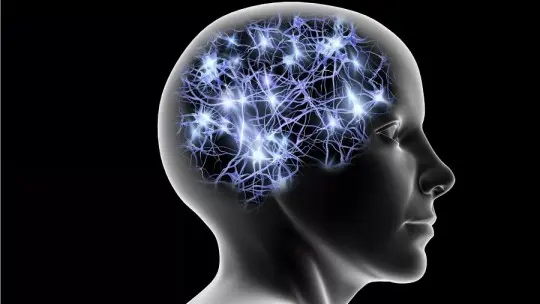Although cognitive dissonance theory has inspired much research, an even simpler theory may explain the link between behaviors and attitudes. Consider, for example, the insinuations we make about the attitudes of others: we see how a person acts in a particular situation and then attribute the behavior to his or her traits and attitudes or to environmental forces.
If we see parents forcing their 10-year-old to apologize, we attribute the apology to the situation, not their own personal regret. Self-perception theory suggests that we make similar inferences when observing our behavior. In this PsychologyFor article, we will see What is self-perception, the theories about it and some examples to improve it.

What is self-perception
When our attitudes are weak or ambiguous, we put ourselves in the position of someone observing us from the outside. Listening to one another while speaking informs us about our attitudes, that is, seeing our actions gives us clues about the solidity of my beliefs.
This is especially true when we cannot easily attribute our behavior to external constraints. The actions we perform deliberately are self-performing. Therefore, the theory of self-perception is that when we are not sure of our attitudes, we deduce them by observing our behavior and the circumstances in which it happens.
Self-perception is how we view ourselves, encompassing our beliefs about our abilities, traits, and overall worth. It plays a crucial role in shaping our behavior, decisions, and interactions with others. Understanding self-perception is essential because it influences our confidence, motivation, and mental health. This article explores what self-perception is, how it develops, and how it impacts various aspects of our lives.
Main theories of self-perception
The two best-known theories that address the concept of self-perception are Leon Festinger’s cognitive dissonance theory and Daryl J. Bem’s self-perception theory.
Festinger’s cognitive dissonance theory
This theory talks about uncomfortable situations where we feel that we are not being coherent, that is, when we come into conflict with ourselves. Specifically, this perspective looks at the attitudes of durable predispositions, such as ideas, thoughts or beliefs. In this article, you will find more information about the theory of cognitive dissonance.
Bem’s self-perception theory
Self-perception theory goes one step further than cognitive dissonance theory. According to this conception, By observing what we do we infer what we like and what we think about it. This theory leads to the same predictions of Festinger’s cognitive dissonance theory, but highlights that attitudes are just random statements, products based on the behaviors we have had so far.
What does self-perception consist of? It is the process by which we go from an idea of pleasure, when producing a behavior, to an idea of obligation. For example, I play tennis because I like it, but if I am paid to do it it becomes an obligation and not a passion.
Contrary to the notion that rewards always increase motivation, Bem maintains that Unnecessary rewards can have a hidden cost Rewarding people for doing what they already do with pleasure can induce them to attribute their action to the reward (extrinsic motivation), thus weakening the self-perception of doing it for pleasure (intrinsic motivation). This refers to the effect of excessive justification.
Examples of self-perception
Self-perception theory has had important consequences in marketing and consumer research. For example, the well-known technique foot in the door in which convincing a client to accept a small request increases the chances that he or she will accept a larger request down the road, has been explained by some researchers as the same process as self-perception.
As the Consumer Research Association (1976) points out, foot in the door is assumed to be effective because people use their behavior as a starting point for their dispositions of aptitude. Since external pressure for initial behavior is assumed to be minimal, people infer a positive attitude from their compliant behavior, which in turn drives the next action.
Another example of self-perception would be when we are not sure if our attitude could offend someone and, through analysis of our behavior, we try to make that other person not feel bad because it is important to our parents. If we achieve our objective, we will have a good self-perception of ourselves, since we have managed to avoid conflict and fulfill our mission.
How to improve self-perception
As we have seen previously, self-perception changes depending on how we behave at any given moment. Next, we will see two ways to improve self-perception:
- Train self-perception without performance anxiety: to train perception, conscious perception is needed, since we cannot assume that it is trained implicitly. To focus on perception, it takes time and a lot of concentration, without distractions. Therefore, exercises should be performed without performance anxiety and without any competitive intention, in order to focus on themselves and not on the results.
- Intense observation: relaxation exercises are particularly indicated to perceive yourself consciously; They also serve to feel what is pleasant and sharpen the senses. An intensive observation of one’s body’s signals, feelings and thoughts is a prerequisite for empathetic behavior. For those who listen to and appreciate themselves, it is easier to perceive and pay attention to others, their feelings and their demands.
Components of Self-Perception
Self-Concept
Self-concept is the comprehensive view we have of ourselves. It includes our self-image (how we see ourselves) and our self-ideal (how we would like to be). This concept forms the foundation of our self-perception and influences our behavior and interactions.
Self-Esteem
Self-esteem refers to how we evaluate our worth. It’s closely tied to self-perception; a positive self-perception usually leads to higher self-esteem, while a negative one can result in lower self-esteem. Self-esteem affects our confidence and how we handle challenges and criticism.
Self-Identity
Self-identity is our sense of who we are, including our values, beliefs, and personal roles. It is shaped by our experiences and how we perceive ourselves in different contexts, such as in our personal lives, careers, and social circles.
How Self-Perception Develops
Early Influences
Self-perception begins to form in childhood through interactions with family, friends, and significant adults. Early feedback and experiences contribute to our initial self-concept and self-esteem.
Social Interactions
As we grow, our self-perception is influenced by social interactions. Peer feedback, social comparisons, and societal expectations play significant roles in shaping how we see ourselves.
Cultural and Environmental Factors
Cultural norms and environmental factors also impact self-perception. Societal standards, cultural values, and external feedback from media and community shape our self-image and self-esteem.
Self-Perception and Self-Esteem
Relationship Between Self-Perception and Self-Esteem
Self-perception and self-esteem are closely linked. A positive self-perception generally leads to high self-esteem, while a negative self-perception can lower self-esteem. This relationship affects how we view ourselves and our overall happiness.
Positive vs. Negative Self-Perception
A positive self-perception enhances confidence, motivation, and resilience. In contrast, a negative self-perception can lead to self-doubt, anxiety, and depression. It’s important to recognize and address these perceptions to foster mental well-being.
Impact on Mental Health
Self-perception significantly impacts mental health. Those with a negative self-perception may struggle with issues like depression, anxiety, and low self-worth. Improving self-perception can lead to better mental health and emotional stability.
The Role of Social Media
Influence of Online Presence on Self-Perception
Social media has a profound impact on self-perception. The curated images and success stories we see online can affect how we view ourselves and our worth. Social media can lead to unrealistic comparisons and influence our self-esteem.
Comparisons and Self-Esteem
Comparing ourselves to others on social media can distort our self-perception, often leading to feelings of inadequacy or jealousy. It’s crucial to be mindful of these comparisons and focus on self-compassion and self-acceptance.
Managing Social Media Influence
To manage social media’s influence, limit exposure to negative content, focus on positive interactions, and practice self-compassion. Developing a healthy online presence and setting boundaries can help maintain a balanced self-perception.
Self-Perception and Personal Growth
How Self-Perception Affects Personal Development
Self-perception influences our personal growth by affecting our motivation and self-confidence. A positive self-perception encourages us to pursue goals and embrace challenges, while a negative self-perception can hinder growth and achievement.
Strategies for Improving Self-Perception
- Self-Reflection: Regularly assess and reflect on your self-perception to identify areas for improvement.
- Goal Setting: Set and achieve small goals to build confidence and positive self-view.
- Positive Affirmations: Use affirmations to challenge and change negative beliefs about yourself.
Benefits of a Positive Self-Perception
A positive self-perception can lead to increased motivation, better relationships, and overall life satisfaction. It helps build resilience, fosters personal development, and enhances well-being.
Common Distortions in Self-Perception
Self-Serving Bias
Self-serving bias is the tendency to attribute positive outcomes to our own actions while blaming external factors for negative outcomes. This distortion can skew our self-perception, leading to an inflated sense of self-worth.
Confirmation Bias
Confirmation bias involves seeking out information that supports our existing beliefs about ourselves while ignoring contradictory evidence. This bias can reinforce inaccurate self-perceptions and limit personal growth.
The Halo Effect
The halo effect is the tendency to let our overall impression of someone influence our judgments of their specific traits. In self-perception, this can mean letting a single positive or negative experience overshadow our overall self-view.
Exercises to Enhance Self-Perception
Journaling and Reflection
Journaling helps in understanding and clarifying your thoughts and feelings about yourself. Reflecting on positive experiences and accomplishments can improve self-perception.
Affirmations and Positive Self-Talk
Using affirmations and engaging in positive self-talk can challenge negative self-beliefs and reinforce a more positive self-perception. Practice affirmations daily to build a healthier self-image.
Seeking Feedback from Others
Constructive feedback from trusted individuals can provide valuable insights into your self-perception. It can help identify blind spots and validate strengths, leading to a more balanced self-view.
Self-Perception in Relationships
Impact on Romantic Relationships
Self-perception affects romantic relationships by influencing how we interact with partners and perceive their actions. A positive self-perception fosters healthier relationships, while a negative self-view can lead to insecurity and conflict.
Influence on Friendships and Family Dynamics
Our self-perception impacts how we relate to friends and family. A positive self-perception enhances social interactions, while a negative self-view can strain relationships and create misunderstandings.
Strategies for Improving Relationship Dynamics
- Open Communication: Discuss your feelings and self-perception with loved ones to foster understanding and support.
- Empathy: Practice empathy to better connect with others and improve relationship dynamics.
- Self-Improvement: Work on personal growth and self-awareness to enhance relationships.
Self-Perception and Career Success
How Self-Perception Affects Professional Growth
Self-perception influences career success by affecting confidence, motivation, and performance. A positive self-view can drive professional growth, while a negative self-perception can hinder career advancement.
Overcoming Implicit Bias
Addressing implicit biases and challenging negative self-perceptions can improve professional interactions and opportunities. Focus on developing skills and building confidence to enhance career success.
Building Confidence in the Workplace
Building confidence involves recognizing your strengths, setting achievable goals, and seeking professional development opportunities. A positive self-perception boosts workplace performance and career advancement.
The Science Behind Self-Perception
Psychological Theories and Models
Various psychological theories, such as Carl Rogers’ self-theory and George Herbert Mead’s symbolic interactionism, explore self-perception. These models provide insights into how self-concept and self-identity are formed and maintained.
Neuroscience of Self-Perception
Neuroscience studies reveal how brain regions, like the medial prefrontal cortex, are involved in self-perception. Understanding these neural mechanisms can shed light on how we process and evaluate our self-view.
Research Findings
Recent research highlights the dynamic nature of self-perception and its impact on mental health and behavior. Studies show that self-perception can be altered through interventions and self-reflection.
Case Studies and Examples
Real-Life Stories of Self-Perception Changes
Exploring real-life stories of individuals who have transformed their self-perception can provide inspiration and practical insights. These stories demonstrate the impact of self-perception on personal and professional lives.
Famous Figures and Their Self-Perception
Famous figures often undergo significant changes in self-perception throughout their lives. Examining their journeys can offer valuable lessons on overcoming self-doubt and embracing personal growth.
Lessons from Case Studies
Case studies offer practical examples of how self-perception influences behavior and success. Learning from these examples can help individuals navigate their self-perception challenges and opportunities.
Difference between self-concept and self-perception
Self-concept is understood as the image we have created of ourselves: not just a visual image, but the set of ideas that we believe define us, on a conscious and unconscious level. This includes an almost infinite number of concepts that could be included in this “image” about ourselves, as each idea can contain many more within it, creating category systems that are one within the other.
In summary, self-concept is the set of characteristics (aesthetic, physical, emotional, etc.) that serve to define the image of oneself. Instead, through self-perception, we define the perception of one’s own mental states achievable by observing one’s own behaviors, as if one were an external observer, or by introspection.
Understanding self-perception is crucial for personal and professional development. By exploring its components, influences, and effects, we can gain valuable insights into how we view ourselves and how it impacts our lives. Improving self-perception through self-reflection, positive practices, and managing external influences can lead to greater well-being and success.
FAQs
How can I change my self-perception?
Changing self-perception involves self-reflection, setting goals, and practicing positive affirmations. Seek feedback and engage in activities that challenge negative beliefs.
What are some signs of poor self-perception?
Signs of poor self-perception include low self-esteem, self-doubt, and frequent negative self-talk. Individuals may also struggle with anxiety or depression related to self-view.
Can self-perception impact physical health?
Yes, negative self-perception can lead to stress and health issues, while a positive self-view can contribute to better overall health and well-being.
How does self-perception affect decision-making?
Self-perception influences confidence and risk-taking in decision-making. A positive self-view can lead to more assertive and successful decisions.
Are there any professional resources for improving self-perception?
Professional resources include therapy, coaching, and self-help books. Seeking support from mental health professionals can provide personalized strategies for improving self-perception.
This article is merely informative, at PsychologyFor we do not have the power to make a diagnosis or recommend a treatment. We invite you to go to a psychologist to treat your particular case.
If you want to read more articles similar to Self-perception: what it is, theories, examples and how to improve it, we recommend that you enter our Cognitive Psychology category.
Bibliography
- Myers, D. G. (2009). Social Psychology. Milan: McGraw-Hill.
- The Decision Lab (2021). Self Perception Theory. Retrieved from: https://thedecisionlab.com/reference-guide/psychology/self-perception-theory/








